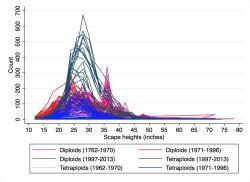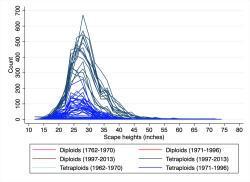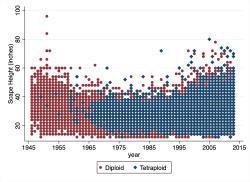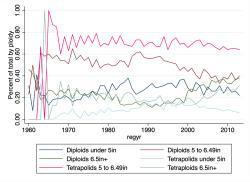kousa said:I meant crossing F1 with F1 sibs and/or F2 (offsprings) back to F1. I have heard that if you do such inline breeding, you will have more chance on seeing something unique because you may happen on a recessive trait being expressed due to a combination of recessive alleles.
Thank you.
Crossing F1 seedlings with F1 seedlings to produce the F2 generation is inbreeding. Unique characteristics rely on new mutations. Mutations are very rare but can occur in every generation. Approximately 95% of new mutations produce characteristics that are "recessive" and not visible when they first occur. The remaining 5% produce characteristics that are "dominant" when they first occur and immediately visible.
Yes, if you inbreed you have a better chance of finding new characteristics than if you do not inbreed.
However, there is a negative side to inbreeding, even just to produce the F2 generation. Both Stout and Arisumi indicated that inbreeding depression is severe in diploid daylilies. According to genetic theory inbreeding depression should be much less severe in tetraploid daylilies.
Inbreeding depression will appear in the seedlings in any of many different ways. Inbred daylilies may be slower growing, have fewer buds, have more problems opening their flowers, have less substance to their flowers, have less robust scapes, fewer scape branches, increase at slower rates, be less cold hardy, less disease resistant, less fertile, have smaller seeds and fewer seeds, have smaller flowers, and so on. The greater the inbreeding the stronger the inbreeding depression the worse the negative effect on the plant's characteristics. These negative effects are all in comparison to the average values of the characteristics in outbred daylilies.
Inbreeding depression would be measured by crossing a daylily to several unrelated plants, chosen at random and measuring the characteristics of the seedlings (outbred seedlings). Then those measurements would be averaged. The plant would then be self-pollinated and the same characteristics would be measured on the inbred seedlings. The difference between the average measurements of the inbred seedlings versus the average measurements of the outbred seedlings is an estimate of inbreeding depression. To get a better estimate of how inbreeding depression affects any specific character crosses would be made with the plant to produce different amounts of inbreeding and the seedlings from those crosses would have their characteristics measured. To get a more general estimate of how inbreeding affects various characteristics in daylilies in general the whole thing would be repeated with more than one original daylily.
Since these effects are based on average values of many seedlings it means that in any group of seedlings there will be ones with less than average values of the characteristics and ones with more than average values of the characteristics. That means if enough inbred seedlings are produced it is possible that the hybridizer may be able to choose specific seedlings that are not as badly affected by the inbreeding and sometimes not affected at all. That is partially based on inbreeding levels being different in the seedlings from an inbred cross as well as the characteristics - averages are involved for the inbreeding levels as well.


"Entrapment". Daylily (Hemerocallis 'Entrapment')




